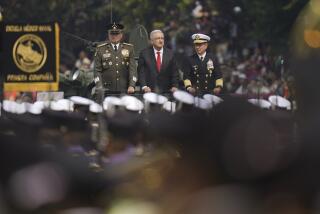Tape Connects Mexico Officer to Drug Torture
- Share via
SAN DIEGO — U.S. authorities have obtained a tape recording of the torture of slain American drug agent Enrique S. Camarena and have identified the man supervising the torture as a Mexican Federal Judicial Police official, according to sources close to the investigation.
Those sources told The Times that the Mexican official is identified by name on the recording and that he is still believed to be at large in Mexico. The recording of the two-day torture session was reluctantly turned over to U.S. officials last year by the Mexican government, the sources said.
Also named on the tape and believed present, the sources said, is accused Mexican drug trafficker Rene Martin Verdugo.
Awaits Marijuana Trial
Verdugo, 34, is in jail here at the Metropolitan Correctional Center awaiting trial on marijuana smuggling charges, and his lawyer has denied that he was present during Camarena’s torture. Verdugo has told a federal judge that he was turned over to U.S. authorities by six men, including four Baja California State Judicial policemen, who kidnaped him Jan. 24 in San Felipe, Baja California, and drove him to the border at Mexicali.
Federal sources familiar with the investigation declined to name the Mexican police official identified on the tape, but they described him as “highly placed.” The sources declined to say whether they have asked Mexican authorities to arrest the official. However, one source said, the Mexican government has been given a list of additional suspects in the case, and the list includes some government and police officials.
Already jailed in the case are a number of suspects, including several Mexican police officers and two Mexican narcotics kingpins accused of masterminding the kidnap-murder.
U.S. investigators explained that the killers taped the torture sessions to keep a record of the information that they extracted from Camarena, a U.S. Drug Enforcement Administration agent stationed in Mexico. “It’s all there. It’s all there,” said one source familiar with the recording.
Camarena’s body was discovered March 5, 1985, near Guadalajara about a month after he was kidnaped on the streets of that city.
A federal law enforcement official familiar with the investigation said that the tape recording was obtained by U.S. officials after they learned that Mexican investigators had the tape.
Hard to Convince
“Once we learned about the tape, it took a great deal of effort to convince the Mexicans to turn it over to us. It wouldn’t be an exaggeration to say that the government of Mexico was very obstructionist in this matter,” said the official, who requested anonymity. “Obviously, they knew that releasing the tape would embarrass them greatly.”
Throughout the case, U.S. officials have complained bitterly that Mexican officials were apparently unwilling to conduct an aggressive investigation of Camarena’s murder, despite the earlier arrests. American investigators have speculated that there is some foot-dragging by their Mexican counterparts in an effort to protect Mexican government and high police officials.
Mexican government officials did not return telephone calls by The Times on Thursday.
U.S. officials who have heard the tape told The Times that Camarena’s screams are “shocking and helpless.” The American agent, who was assigned to the DEA office in Guadalajara, was kidnaped from in front of the U.S. Consulate there Feb. 7, 1985. Federal sources said that the torture began shortly after he was driven to the house of Rafael Caro Quintero, a notorious Mexican drug trafficker currently jailed in a Mexico City prison.
Beaten for Hours
The beatings continued over a period of several hours until the next evening at about 8 p.m., when Camarena is believed to have been killed. Federal sources say that he was beaten to death with a metal rod, possibly a tire iron, and buried. His body was then dug up and placed in a second grave, at a ranch outside Guadalajara. It was discovered March 5.
(Alfredo Zavala Avelar, a Mexican pilot who flew missions for the Drug Enforcement Administration, was abducted on the same day and was also tortured by his abductors before he was murdered, U.S. investigators said. The battered bodies of Camarena and Zavala Avelar were exhumed at the same ranch.)
According to the sources, Verdugo’s voice and name are heard on the tape. In addition, U.S. investigators have recovered other physical evidence that placed Verdugo at the scene of the torture. However, these sources say they do not have any evidence showing that Verdugo participated in the torture sessions.
Howard Frank, Verdugo’s attorney, denied that his client was present during the torture sessions. But Frank did not deny that his client may have been at Caro Quintero’s Guadalajara house at one time.
Question of the Time
“Maybe they do have physical evidence, like a fingerprint or something, that shows that he was at some particular place where something occurred. But that doesn’t mean that he was there when the crime took place. I take great issue with even the suggestion that he was there (when the crime was committed). He wasn’t there,” Frank said.
Verdugo, 34, who is known in Mexican drug trafficking circles as La Rana (the frog), is charged with smuggling about a ton of marijuana from Mexico to Tucson, Ariz., and to Vista, Calif., in 1983. His case has stirred considerable controversy on both sides of the border, stemming from the allegations that he was abducted by Mexican police officers with the knowledge of U.S. law enforcement officials.
On Wednesday, Immigration and Naturalization Service officials acknowledged that the six alleged abductors and their families have been given special permits to remain in the United States. Federal sources have said that the decision was made to bring them into the United States after they reported receiving threats from Mexican drug traffickers upset at their role in the alleged abduction of Verdugo.
H.G. Reza reported from San Diego and Ronald J. Ostrow from Washington.
More to Read
Sign up for Essential California
The most important California stories and recommendations in your inbox every morning.
You may occasionally receive promotional content from the Los Angeles Times.










